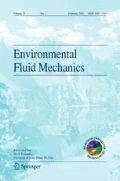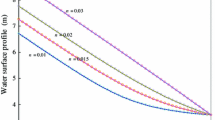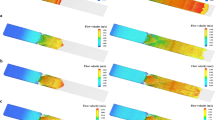Abstract
Dam failures usually cause huge economic and life losses , especially in urban areas where there is a high concentration of inhabitants and economic actors. In order to understand the physical mechanisms of the formation and development of dam-break flooding, lots of efforts have been put into different types of modelling techniques. However, most of existing models are 1D (one-dimensional) or 2D models based on the shallow water equations. In this paper, we present a 3D numerical modelling investigation of dam-break flow hydrodynamics in an open L-shape channel. A newly developed 3D unstructured mesh finite element model is used here. An absorption-like term is introduced to the Navier–Stokes equations in order to control the conditioning of the matrix equation in the numerical solution process and thus improve the stability. A wetting and drying algorithm is used here to allow the free surface height to be treated with a high level of implicitness and stability. The 3D model has been validated by comparing the results with the published experimental data. Good agreement has been achieved at six selected locations. This study shows that the 3D unstructured mesh model is capable of capturing the 3D hydraulic aspects and complicated local flows around structures in simulation of dam-break flows.












Similar content being viewed by others
References
Rahman M, Chaudhry MH (1998) Simulation of dam-break flow with grid adaptation. Adv Water Resour 21(1):1–9
Sakkas JG, Strelkoff T (1973) Dam-break flood in a prismatic dry channel. J Hydraul Div 99(12):2195–2216
Chen Cl (1980) Laboratory verification of a dam-break flood model. J Hydraul Div 106(4):535–556
Garcia R, Kahawita R (1986) Numericl solution of the St. Venant equations with the maccormack finite-difference scheme. Int J Numer Meth Fluids 6(5):259–274
Beam R, Warming R (1976) An implicit finite-difference algorithm for hyperbolic systems in coservation-law form. J Comput Phys 22(1):87–110
Roe P (1981) Approximate riemann solvers, parameter vectors, and difference schemes. J Comput Phys 43(2):357–372
Katopodes N (1982) On zero-inertia and kinematic waves. J Hydraul Div 108(11):1380–1387
Zoppou C, Roberts S (1999) Catastrophic collapse of water supply reservoirs in urban areas. J Hydraul Eng 125(7):686–695
Garcia-Navarro P, Fras A, Villanueva I (1999) Dam-break flow simulation: some results for one-dimensional models of real cases. J Hydrol 216(3):227–247
Aureli F, Mignosa P, Tomirotti M (2000) Numerical simulation and experimental verification of dam-break flows with shocks. J Hydraul Res 38(3):197–206
Tseng MH, Chu CR (2000) The simulation of dam-break flows by an improved predictor-corrector TVD scheme. Adv Water Resour 23(6):637–643
Wang JS, Ni HG, He YS (2000) Finite-difference TVD scheme for computation of dam-break problems. J Hydraul Eng 126(4):253–262
Lin GF, Lai JS, Guo WD (2003) Finite-volume component-wise tvd schemes for 2D shallow water equations. Adv Water Resour 26(8):861–873
Liang D, Falconer RA, Lin B (2007) Coupling surface and subsurface flows in a depth averaged flood wave model. J Hydrol 337(1):147–158
Bai Y, Xu D, Lu D (2007) Numerical simulation of two-dimensional dam-break flows in curved channels. J Hydrodyna Ser B 19(6):726–735
Peng SH (2012) 1D and 2D numerical modeling for solving dam-break flow problems using finite volume method. J Appl Math 2012(4):359–373
Brufau P, Garcia-Navarro P (2000) Two-dimensional dam break flow simulation. Int J Numer Meth Fluids 33(1):35–57
Abdolmaleki K, Thiagarajan K, Morris-Thomas M (2004) Simulation of the dam break problem and impact flows using a Navier–Stokes solver. Simulation 13:17
Liang Q, Borthwick A, Stelling G (2004) Simulation of dam-and dyke-break hydrodynamics on dynamically adaptive quadtree grids. Int J Numer Meth Fluids 46(2):127–162
Aliparast M (2009) Two-dimensional finite volume method for dam-break flow simulation. Int J Sedim Res 24(1):99–107
Xia J, Lin B, Falconer RA, Wang G (2010) Modelling dam-break flows over mobile beds using a 2D coupled approach. Adv Water Resour 33(2):171–183
Campisano A, Creaco E, Modica C (2013) Numerical modelling of sediment bed aggradation in open rectangular drainage channels. Urban Water J 10(6):365–376
Kärnä T, Brye B, Gourgue O, Lambrechts J, Comblen R et al (2011) A fully implicit wetting-drying method for dg-fem shallow water models, with an application to the scheldt estuary. Comput Methods Appl Mech Eng 200(5–8):509–524
Kesserwani G, Liang Q (2012) Dynamically adaptive grid based discontinous galerkin shallow water model. Adv Water Resour 37(1):23–39
Begnudelli L, Sanders BF (2007) Simulation of the St. Francis dam-break flood. J Eng Mech 133(11):1200–1212
Larocque LA, Elkholy M, Hanif Chaudhry M, Imran J (2013a) Experiments on urban flooding caused by a levee breach. J Hydraul Eng 139(9):960–973
Yan J, Cao ZX, Liu HH, Chen L (2009) Experimental study of landslide dam-break flood over erodible bed in open channels. J Hydrodyn Ser B 21(1):124–130
Gottardi G, Venutelli M (2004) Central scheme for two-dimensional dam-break flow simulation. Adv Water Resour 27(3):259–268
Biscarini C, Francesco SD, Manciola P (2010) CFD modelling approach for dam break flow studies. Hydrol Earth Syst Sci 14(4):705–718
Yue W, Lin CL, Patel VC (2003) Numerical simulation of unsteady multidimensional free surface motions by level set method. Int J Numer Meth Fluids 42(8):853–884
Zhang Y, Zeng Z, Chen J (2012) The improved space-time conservation element and solution element scheme for two-dimensional dam-break flow simulation. Int J Numer Meth Fluids 68(5):605–624
Zoppou C, Roberts S (2003) Explicit schemes for dam-break simulations. J Hydraul Eng 129(1):11–34
Soares-Frazão S, Zech Y (2008) Dam-break flow through an idealised city. J Hydraul Res 46(5):648–658
Abderrezzak KEK, Paquier A, Mignot E (2009) Modelling flash flood propagation in urban areas using a two-dimensional numerical model. Nat Hazards 50(3):433–460
Gallegos HA, Schubert JE, Sanders BF (2009) Two-dimensional, high-resolution modeling of urban dam-break flooding: a case study of baldwin hills, california. Adv Water Resour 32(8):1323–1335
Wang X, Cao Z, Pender G, Tan G (2010) Modelling of urban flooding due to yangtze river dike break. Proc ICE-Water Manag 164(1):3–14
Wang Y, Liang Q, Kesserwani G, Hall JW (2011) A 2D shallow flow model for practical dam-break simulations. J Hydraul Res 49(3):307–316
Larocque LA, Imran J, Chaudhry MH (2013b) 3d numerical simulation of partial breach dam-break flow using the les and k-turbulence models. J Hydraul Res 51(2):145–157
Zhang T, Feng P, Maksimović v, Bates PD (2016) Application of a three-dimensional unstructured-mesh finite-element flooding model and comparison with two-dimensional approaches. Water Resour Manag 30:1–19
Funke S, Pain C, Kramer S, Piggott M (2011) A wetting and drying algorithm with a combined pressure/free-surface formulation for non-hydrostatic models. Adv Water Resour 34(11):1483–1495
Frazão SS, Zech Y (2002) Dam break in channels with 90 bend. J Hydraul Eng 128(11):956–968
Geuzaine C, Remacle JF (2009) Gmsh: a 3-D finite element mesh generator with built-in pre-and post-processing facilities. Int J Numer Meth Eng 79(11):1309–1331
Pain C, Piggott M, Goddard A, Fang F, Gorman G, Marshall D, Eaton M, Power P, De Oliveira C (2005) Three-dimensional unstructured mesh ocean modelling. Ocean Model 10(1):5–33
Kenwright DN, Mallinson GD (1992) A 3-d streamline tracking algorithm using dual stream functions. In: Proceedings of the 3rd conference on Visualization’92, IEEE Computer Society Press, pp 62–68
Frazão SS, Sillen X, Zech Y (1998) Dam-break flow through sharp bends-physical model and 2D Boltzmann model validation. European Commission, Brussels
Rao A, Jain I, Murthy MR, Murty T, Dube S (2009) Impact of cyclonic wind field on interaction of surge-wave computations using finite-element and finite-difference models. Nat Hazards 49(2):225–239
Du J, Fang F, Pain CC, Navon I, Zhu J, Ham DA (2013) Pod reduced-order unstructured mesh modeling applied to 2D and 3D fluid flow. Comput Math Appl 65(3):362–379
Xiao D, Fang F, Buchan AG, Pain CC, Navon IM, Du J, Hu G (2014) Non-linear model reduction for the navier-stokes equations using residual deim method. J Comput Phys 263:1–18
Couplet M, Basdevant C, Sagaut P (2005) Calibrated reduced-order pod-galerkin system for fluid flow modelling. J Comput Phys 207(1):192–220
Liberge E, Hamdouni A (2010) Reduced order modelling method via proper orthogonal decomposition (POD) for flow around an oscillating cylinder. J Fluids Struct 26(2):292–311
Acknowledgements
This work was carried out under funding from the National Natural Science Foundation of China (No. 51609165), the Foundation of State Key Laboratory of Hydraulic Engineering Simulation and Safety (Tianjin University, No. HESS-1607), and the China Postdoctoral Science Foundation (No. 2016M591389). The authors would like to thank Prof. Christopher Pain, Prof. Čedo. Maksimović, Prof. Ionel M. Navon, Dr. Alexandros Avdis, Prof. Zhixian Cao for providing advice and help in this research.
Author information
Authors and Affiliations
Corresponding author
Rights and permissions
About this article
Cite this article
Zhang, T., Fang, F. & Feng, P. Simulation of dam/levee-break hydrodynamics with a three-dimensional implicit unstructured-mesh finite element model. Environ Fluid Mech 17, 959–979 (2017). https://doi.org/10.1007/s10652-017-9530-3
Received:
Accepted:
Published:
Issue Date:
DOI: https://doi.org/10.1007/s10652-017-9530-3




